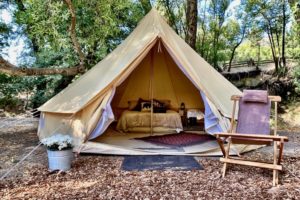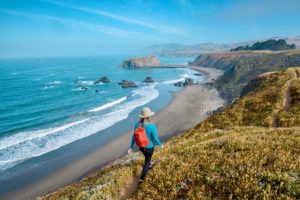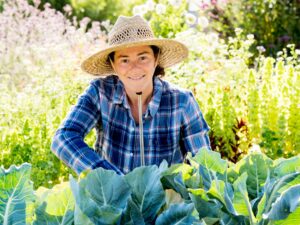The first signs of an approaching storm are subtle. The breezes change from the northwest to the southwest, causing the surface waters of the Pacific Ocean to appear to flow south to north. The horizon is clear and sharp. These are the hours of changes to come.
The day before a major fall or winter storm can be a perfect time to see the elusive green flash at sunset. Watching the sunset is a coast tradition. Watch for the moment the sun sinks below the horizon. If the conditions are perfect, you may see an emerald glow enveloping the top of the departing sun, a photographable mirage caused by refraction bending the light of the setting sun.
It doesn’t flash across the horizon. It’s as if someone on the other end of the sunset held a flashlight glowing green. Don’t blink. It’s over in a flash.
Fun Fact: Legend says it’s good luck to see a green flash.
Winter brings the most storms. As one nears, waves pick up the story. Big swells stretch out as far as you can see. When waves hit rocky bluffs, water is hurled into the air. Enormous breakers crash on sandy beaches, and a salty mist can be seen floating over Highway 1.
A storm is coming, a big one.
Meteorology has come a long way, predicting storms with great accuracy. Various weather apps, including a great one from the National Oceanic and Atmospheric Administration, or NOAA, give updated storm alerts, and many coast residents have weather stations with a barometer. A falling barometer will alert you to batten down the hatches. On Monday, in advance of a wild winter storm, the barometer looked like a steep descending staircase.
If a storm comes from the north, as they did in December, the leading edge can be seen. Clouds build and darken, and the wind begins to pick up in intensity. Outdoor barbecues have been blown off decks, and potted plants have been moved by the force of the wind. It’s dangerous to walk in a forest at this time because of falling tree limbs.
If the storms are El Niño-driven, like the three that hit this week, they come in directly from the Pacific and envelop the coast. They are warmer and have more rain. The storms slam into the unprotected coast, and it’s quite exhilarating and sometimes terrifying.
To experience a storm outdoors, as John Muir might have, finding a safe place is your number one priority. Margaret Lindgren, owner of Sea Ranch-based Unbeaten Path Tours, suggests Salt Point State Park as the best viewing spot. “There are many rocky overlooks that are safe,” she said. “The bluff edges anywhere are too dangerous now after the heavy rains. Stick to solid, rocky outcroppings.”
Lindgren says the Gerstle Cove entrance at Salt Point SP has many such safe outlooks.
A little further north, in Mendocino County, the top of the Point Arena Lighthouse would be an exhilarating place to experience a storm. It’s also a prime spot for whale watching and bird watching.
To photograph the majestic storm waves, coastal photographer Craig Tooley advises, “The best time to photograph is either early in the morning or late afternoon, because the light is more dramatic.”
Perhaps you’d rather experience the storm from inside a local inn or restaurant. One excellent place to watch a storm is from a front row table at the Black Point Grill at The Sea Ranch Lodge. It’s also a great place to see gray whales, currently migrating southward. Timber Cove Inn is another perfect spot, but it is closed for remodeling until April. Both places have hiking trails to explore once the weather clears.
After a storm, the coast is often blessed with a rainbow day. Once the showers have cleared away, it’s time to see what prizes Mother Nature might have tossed up on the beach. Prizes to look for on beaches include abalone shells, with their striking iridescent interiors. Most common finds are plastic bottles, chunks of foam and fishing lines, but more unusual and unlikely items wash up on the Sonoma Coast.
The current off the Sonoma Coast, the California Current, also brings items from Asia. An intact Japanese Ushio light bulb. A plastic clothes basket with barnacles growing over the Asian characters on its sides. A towel with Japanese writing and a drawing that survived its long journey here, deemed by NOAA to be possible tsunami debris.
You also might find a large, green glass Japanese fishing ball caught in the rocks. These fishing floats have broken loose from fishing nets in Japan in years past. They go up around the Aleutian Islands and Alaska, and down the West Coast. If you are very lucky, one of these balls will wash up on a beach intact and you will have a treasure from the other side of the world.
Mel Smith, of Point Arena, is a lifelong beachcomber, and he has amassed the collection of a lifetime: 35 assorted glass floats. He says, “If you go out and look at the residue of humanity, it’s amazing what you can find.”
Smith advises picking up garbage and looking at every little thing. He looks in nooks and crannies, under and behind driftwood. On one remote, small cove off Mendocino County, he found five glass balls.
After a big storm, waterfalls have been replenished and are wondrous to see. It’s a short walk to see the waterfall at The Sea Ranch Stengel Beach public access trail. Often a rainbow appears, reflected off the falling water. The Salal Trail boasts a spectacular series of cascades. The trail head of this Sea Ranch public access trail is found just past the pay station at Gualala Point Regional Park. Park on the left and look for the sign.
An annual pass to Sonoma County Regional Parks gives you entry to all the Sea Ranch public trails and Gualala Point.
Another waterfall to discover is northward at the Point Arena-Stornetta Lands. You can park on Lighthouse Road, on the left before the entrance to the lighthouse. Walk south until you come to a stream, carefully ford the stream, walk a little further and look back. A gorgeous waterfall will be your reward, with the lighthouse in the distance.
Seasonal creeks are running free to the Pacific Ocean, as are our rivers. The Gualala River opened in December for the first time in months. Steelhead, trapped in luxury over the summer and fall, were sent on the next part of their journey as they were swept out to the ocean.
Experiencing a storm and its aftermath on the Sonoma Coast is sure to create a lifelong memory of nature’s power and immense beauty.
Jeanne A. Jackson is the author of “Mendonoma Sightings Throughout the Year,” a month-by-month look at nature on the Sonoma/Mendocino coasts. She writes a weekly nature column in the Independent Coast Observer in Gualala. Jackson regularly posts nature photos of the coast on her website, mendonomasightings.com.










